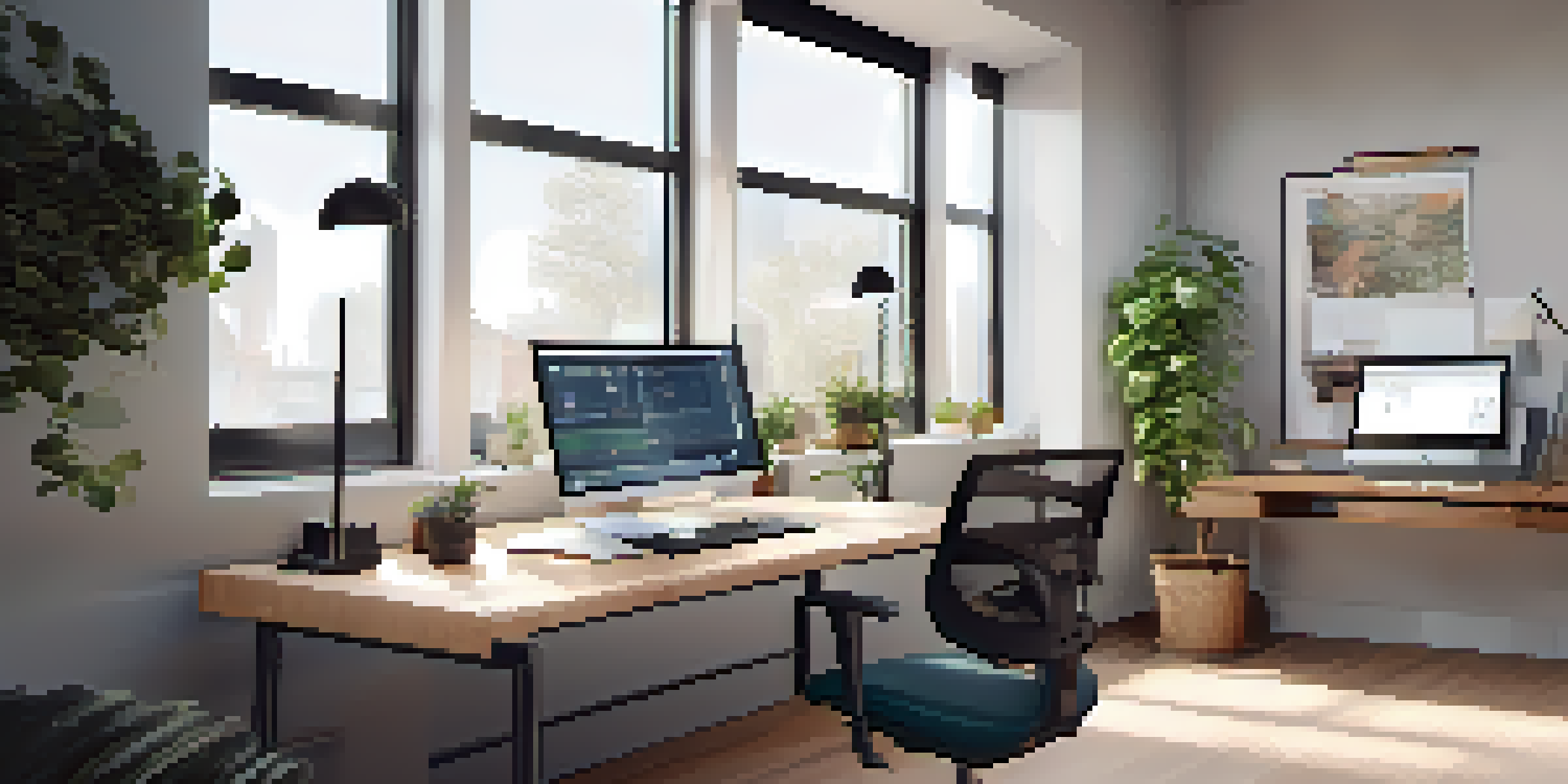Ergonomics: Designing Workspaces for Employee Comfort

Understanding Ergonomics and Its Importance
Ergonomics is the science of designing workspaces to fit the needs of employees, promoting comfort and efficiency. Imagine trying to work at a desk that’s too high or too low—it's not just uncomfortable; it can lead to long-term health issues. By focusing on ergonomic principles, companies can create environments where employees thrive, boosting overall productivity.
The design of workspaces can significantly affect employee performance and well-being.
The importance of ergonomics can't be overstated. When workers are comfortable, they’re less likely to experience fatigue or injuries, which can lead to absenteeism. Plus, a well-designed workspace can enhance focus and creativity, leading to better job performance and satisfaction.
In a world where remote work is becoming the norm, understanding ergonomics is even more critical. Whether employees are in an office or at home, applying ergonomic principles can help create a workspace that supports their well-being and productivity.
Key Principles of Ergonomic Design
When designing an ergonomic workspace, several key principles should be considered. These include adjusting workstation height, ensuring proper posture, and optimizing the placement of tools and equipment. For instance, a chair should support the lower back, while a computer screen should be at eye level to minimize strain.

Another essential aspect is the arrangement of items within arm's reach. Think about how often you stretch or twist to grab something that's too far away. By placing frequently used items within easy reach, you can reduce unnecessary movements that may lead to discomfort or injury over time.
Ergonomics Boosts Comfort and Productivity
Implementing ergonomic principles in workspaces leads to greater employee comfort, reduced injury risk, and enhanced productivity.
Lastly, consider the importance of lighting and noise levels. Proper lighting can reduce eye strain, while minimizing distractions can help maintain focus. All these elements work together to create a workspace that supports both comfort and productivity.
Common Ergonomic Issues in Workspaces
Despite the benefits of ergonomic design, many workspaces still have common issues that can affect employee comfort. For example, improper chair height or desk layout can lead to chronic pain in the neck, back, or wrists. These problems often stem from a one-size-fits-all approach, ignoring individual needs.
Creating a comfortable work environment is not just a luxury; it's a necessity for productivity.
Another frequent issue is the lack of breaks. Employees might feel pressured to work through discomfort, which can exacerbate ergonomic problems. Encouraging regular breaks and stretches can significantly reduce the risk of repetitive strain injuries and improve overall well-being.
Lastly, technology can also be a source of ergonomic challenges. Laptops, for instance, are convenient but often place users in awkward positions. By providing adjustable equipment and promoting good practices, companies can help mitigate these challenges and create a healthier work environment.
Creating an Ergonomic Workspace: Steps to Follow
Creating an ergonomic workspace doesn't have to be overwhelming. Start by assessing the current setup—look for potential hazards or discomfort points. This can include evaluating chair height, desk arrangement, and the positioning of screens and keyboards. Simple adjustments can often make a significant difference.
Next, involve employees in the process. Everyone has different needs, so gathering feedback can help tailor the workspace to individual preferences. Consider conducting surveys or holding meetings to discuss ergonomic concerns and solutions.
Common Ergonomic Issues Persist
Many workspaces still face ergonomic challenges like improper chair height and lack of breaks, which can lead to chronic pain and discomfort.
Finally, invest in ergonomic furniture and tools. This could mean providing adjustable chairs, standing desks, or ergonomic keyboards and mice. By offering these resources, companies show their commitment to employee health and productivity.
The Role of Technology in Ergonomics
Technology plays a pivotal role in enhancing ergonomic design. For example, software can help monitor posture and remind users to take breaks. This proactive approach can help prevent discomfort before it becomes a more significant issue, allowing employees to work more effectively.
Additionally, ergonomic tools like sit-stand desks and adjustable monitor arms allow for greater flexibility in how employees work. These tools can be tailored to individual needs, promoting a more personalized workspace that encourages movement and reduces fatigue.
Moreover, advancements in virtual reality (VR) and augmented reality (AR) are opening new doors for ergonomic training and assessments. These technologies can provide employees with immersive experiences that teach them about proper posture and workspace setup in a fun and engaging way.
Benefits of Ergonomic Workspaces for Employees
The benefits of ergonomic workspaces extend beyond comfort; they can lead to increased job satisfaction and morale. When employees feel cared for, they are more likely to be engaged and motivated. A comfortable environment can foster a positive company culture, where individuals feel valued.
Furthermore, reducing physical discomfort translates into fewer sick days and lower healthcare costs for companies. By prioritizing ergonomics, businesses can minimize the risk of injuries, which ultimately benefits the bottom line.
Future Trends in Ergonomic Design
The future of ergonomic workspace design will focus on remote work solutions, biophilic design elements, and innovative technology to enhance employee well-being.
Lastly, an ergonomic workspace encourages productivity. When employees are not distracted by discomfort, they can focus on their tasks and perform at their best. This boost in productivity can lead to better outcomes for both the employees and the organization.
Future Trends in Ergonomic Workspace Design
As we look to the future, ergonomic workspace design is likely to evolve with changing work trends. Remote and hybrid work is here to stay, prompting a shift in how we think about ergonomics at home. Companies may begin to offer resources and stipends for home office setups, emphasizing the importance of ergonomics outside traditional office environments.
Additionally, the incorporation of biophilic design—integrating natural elements into the workspace—can enhance comfort and well-being. Studies show that access to natural light and greenery can reduce stress and boost productivity, making it a valuable addition to ergonomic considerations.

Finally, as technology continues to advance, we can expect more innovative solutions for ergonomic design. From smart furniture that adjusts automatically to wearable devices that track posture, the future of ergonomics looks promising, paving the way for healthier and more productive work environments.